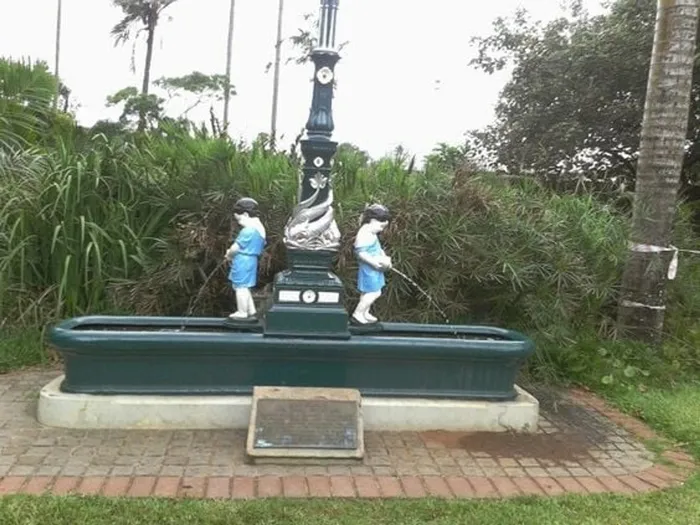Pouring cold water over drinking fountain

The HW Currie Memorial Fountain soon after it was moved to Durban’s Botanic Gardens in 2005.
The old picture this week features the Currie Memorial Fountain which for many years stood at the corner of Point (now Mahatma Gandhi) and West (Dr Pixley kaSeme) streets.
It is one of two examples of Victorian Scottish decorative ironwork in the city, along with the Da Gama Clock.
In 1878, a drought and shortage of water prompted Councillor Henry William Currie to sink an artesian well in search of water in the area below the Botanic Gardens. Water was struck and the well, named Currie’s Fountain, delivered more than 225 000 litres of water to the town every day. Currie’s Fountain sports ground today stands on or about the site. In 1889 a lampost and drinking fountain was erected to the memory of Currie.

Allan Jackson in Facts About Durban takes up the story.
“The drinking fountain is modelled after Brussels’ famous Manneken Pis but Durban incorporates two little boys in its design. Prudery wins the day, however, and the boys do not add water to the fountain in the traditional ‘Mannekin’ way but end up pouring it out of pots,” he writes.
By the early 2000s, it was looking like a “very sad little monument indeed”. There were pieces broken off it, one of the figures was leaning at an odd angle, cracks had appeared and the paintwork was in a very bad state. Then it disappeared. I thought that it had found its way to a scrap metal dealer but I was happy to discover that it had been removed for restoration,” he writes.
Martin Prange, of the eThekwini Municipality Urban Design Department, confirmed that the work was done at Keith Clayton Welding in Pinetown. “The monument was taken apart, sandblasted and aluminium mouldings were made to replace the missing pieces. Restoration took about a year and in 2005 it was erected in the Botanic Gardens, next to the lake.”
A question mark hangs over the maker of the fountain. Jackson said papers from Durban’s City Architect’s Department said the fountain was produced by Walter Macfarlane & Co. However, two fountains with identical elements have been discovered at St Arvans near Chepstow in Wales and in East Linton in Scotland.

On the St Arvans fountain, the two boys and the dolphins decorating the base of the central post are identical to the ones on the Durban fountain. The St Arvans fountain doesn’t incorporate a lamp post and has a much larger bowl and a smaller one set into its base where animals can drink. It cost £30 and was opened in 1893.
The East Linton fountain incorporates the same boys as the ones in Durban and St Arvans. It was cast by George Smith & Co at the Sun Foundry in Glasgow and erected in 1882, after a donation of £100. The Sun Foundry operated from 1857 to 1899 and was one of the most important makers of decorative cast iron in Scotland, second only to Walter Macfarlane & Company at their Saracen Foundry.
Jackson says a report compiled when the St Arvans fountain was restored states that all three fountains were made by the Sun Foundry in Glasgow and that the differences between the three can be explained by the fact that foundries often made things in modular fashion, allowing customers to mix and match.
Jackson sent a picture of Durban’s fountain to the co-publisher of a site on Scottish ironwork, David Mitchell, who works for the Conservation Research and Education Group of Historic Scotland. He said Mitchell replied that Currie’s Memorial Fountain was definitely a Sun product. He said the various foundries guarded their designs jealously and would have pursued anyone who tried to copy them.
The Independent on Saturday
Related Topics: